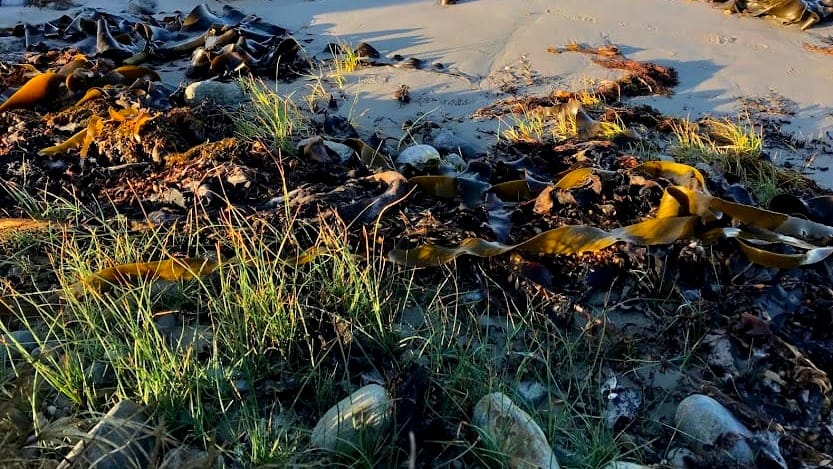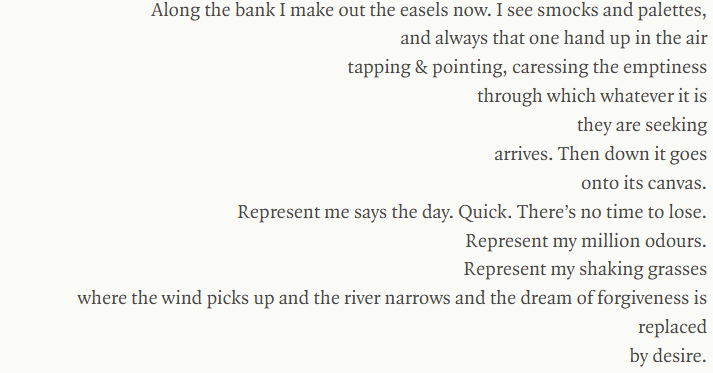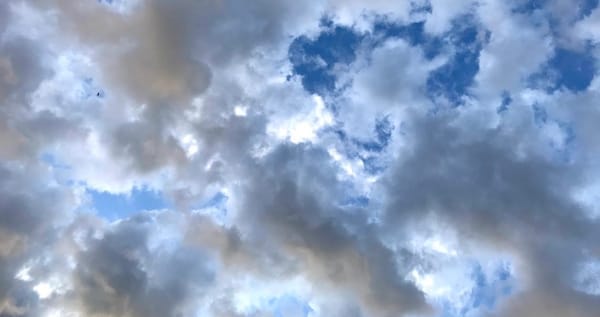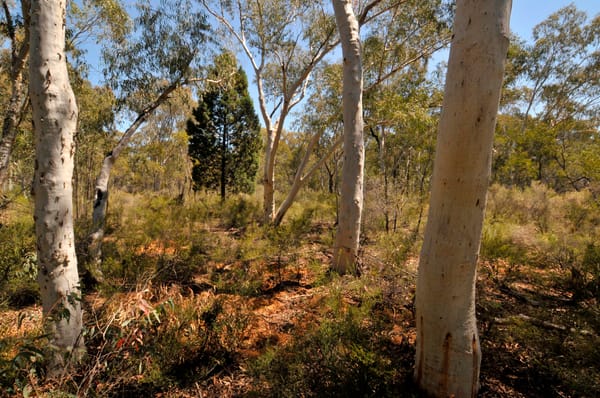Back to reality: read poetry, not political debates

During two days of parliamentary debate about Australia’s national environment laws this week, I was reminded of the guest lecture I gave in September at the University of Newcastle for Professor Patricia Pender, in her course “Writing for Social Change.” The piece below is adapted from that lecture and I am grateful to Trisha for the invitation, and her class for their engagement - it was a great joy to indulge in some close study of poetry and prose.
The piece is about environmental writing for change and I’m sharing it because watching those speeches this week only intensified my conviction that we are in a period of great reckoning and we’re not going to come through that reckoning with a more whole society unless we get in under the deep cultural drivers of our alienation from the real world, the world that makes us. Needless to say, the law that is in parliament this month will take this country deeper into its mistakes, but political debates and media releases aren’t going to amend that. We really do need art, particularly poetry. This question of what art, writing and reading can and must do is urgent and necessary because these practices awaken experiences that are only available communally. The tasks that have been given to us cannot be undertaken individually, so making this collective experience possible is urgent.
Attention to the real world is the kernel. When material experience is revived, whether through direct contact with nature or through art, the lonely modern self is transformed, enlivened, created and made free by its connections and relationships. The process of this revival is crucial to reversing and even to surviving ecological collapse. Through it, the selfhood of the modern individual in relationship to the world and community is renegotiated and that enlarged self gains access to a collective experience that expands the possibilities of action.
The first role of environmental writing is to bring the world back to our people’s attention - exposing environmental harm, tracing the systems of food, energy and waste that sustain us, the origins and destinies of the materials that we touch. It is a great challenge to show our people what is right in front of them because our material relationships have been deliberately obscured by the economic system that has been growing in power and domination over the world for the last few centuries. Mere description and exposition, however, will not do. We need to feel again that we are part of the world
Art is grounded in experience, but to bring the truth of a modern individual existence and the experience of that existence together in the frame of one text seems barely possible now that the truth of our existence extends to parts of the world with which we have no experience. I have no experience of England and Scotland, for example, the roots of my cultural and familial ancestry, nor with the places in Asia where much of what I touch is fabricated by people I will never meet, nor the mines in central Africa and remote China where material is scraped by hand or chemical-stripping from the earth, enabling me to communicate with more people that I will never encounter, nor with the upper atmosphere where the pollutants I create are mingling with the pollutants of people long dead. I have never smelled, or touched or seen these places, and yet they are part of me. Without experience of these material realities, the truth of my existence is obscure to me. This fatal dislocation not only stymies activism, it likewise drains art of its truth. And yet, the formal qualities of art, and particularly poetry, have unique capacities to hold and express these truths. Reviving attention to material realities is a bodily process so begins with creation and experience of form and its pleasures.
Being present: “In reality”
Jorie Graham has a recent poem called “In reality.” Since reality is where we need to be, let’s begin there. The poem charts a poetic persona drifting down river towards the sea, a journey aborted by the drying up of the river. In the course of the poem, motifs recur, and carry us downstream. One of these is the changing light: as well as the river’s course, the poem tracks the passage of a day and its changing qualities of light.
Graham’s jagged long and short lines are justified to the right of the page. This makes reading a little arduous. Bringing friction to reading, making it strenuous, is one way of securing our attention to the material world and reminding ourselves that words are things too. It takes time to read a lengthy poem with long lines and finely crafted syntax. Graham spoke to the Paris Review twenty years ago about her poetic method and how intensively she revises her poems, manually cutting out line fragments with scissors and sticking line breaks in different places in large notebooks to get the poem’s rhythmic stresses to fall in the right places. In this, she cultivates attention to the poem’s material qualities, its shape on the page as our eye reads, the vibration of it in our throat, the music of it in our mind or ear. There is meaning in all of this, of course, but equally important is the sensual pleasure of reading Graham’s poems aloud.
In that Paris Review interview, Graham said she wanted to recall people to their bodies through poetry. She asserts that moral action and a fitting response to the emergency of the dying world requires sensual connection and the revival of bodily presence. This is why form is so important. The sound, the rhythm, the way your eye moves, the stretch of time you take in reading, all recall you to the world. “In Reality” is alive with repetition, assonance and rhyme and these pour out in the opening sequence. There is assonance in the repetition of “widening” “widening” then “while” and “sky” which we return to with “eye” with “trying” and “light.” The patterns are lyrical, but they are also ecological: reproduction with variation is evolution’s way, as is continuous interrelationship. Graham spoke in the interview about involving the reader in her poetry as a way to create that sense of community which she sees as necessary to reverse environmental degradation.
The poem, like the river, has several bends. The persona rounds a corner and encounters something new or strikes a new tone. “A parrot flew over” is the first bend. The poem turns like a river and there is a change in the scene and syntax. The poem until that point is two long and meandering sentences over many lines. Then the parrot flies over in the first of four short sentences in quick succession. These awaken attention from the sprawl of the poem’s opening: the persona sits up, and so does the reader. At another bend the persona watches flying insects and thinks “they see nothing we see.” The poem tangles into repetition of the outward seeing “eye” and the one that sees, “I.”
This swing from eye to eye passes through three different human observers with distinct gestures and qualities: a surveyor, a group of painters, and a poet, the poem’s persona. Each of these vocations reads and interprets the landscape and the environment through different means. A surveyor is a confident taker of land’s measure, a creator of property boundaries. In the poem they are “fitted out for life,” looking at the world through spyglasses and laughing. The next human observers are painters on the river bank. These make an exquisitely expressive gesture in their attention and recreation of the world through their craft:

The syntax of these marvellous lines mimics the gesture they describe, the words pointing and caressing an emptiness until whatever it is/ they are seeking is brought into material being by the poem. The subject of this complex clause begins located in “that one hand,” then shifts to the painters themselves, (“they are seeking”) and finally moves to the emerging “whatever it is,” which arrives, enjambed, over the next line, to be brought into art work.
The third human observer is the poet persona herself and she experiences the unfolding scene and relays it to us, talking to herself and listening to the sounds around her. For the poet, because she works with words, the landscape is speaking. It is asking for representation but also speaking for itself– the shadows cast by the trees on the river face tell stories; the cracks in the sand tell the persona what to do next. To speak, to ask for representation, requires selfhood, so Graham engages with a natural world that is sovereign and self-realised. Moreover, there is no breach between experience and representation: the painters and the poet are both making art that is continuous with the world.
Alexis Wright and the borderless possibilities
The continuous world unfolds on vast scales in Alexis Wright’s novel Praiseworthy wherein time, country and climate change are shown to be so boundless that they are beyond individual ken and may only be accessed communally. In the companion essay “Dream Geographies,” published in Heat, Wright describes the challenge of making form expressive of the world in its beauty and brokenness. She says answering this challenge means grappling with scale, a negotiation between particulars and the infinite. It also means grappling with the ongoing harms of colonisation and representing in literary form the relationship her people bear to the natural world: “A deep consciousness working behind the creative process acknowledges the sheer scale of brokenness in the world.”
Three vastnesses of scale are tackled in the essay and the novel: first, the infinite vibrancy of the living world. It far outstrips human possibility and human calamity and so access to this world requires a collective selfhood that encompasses the non-human. Second, the vastness of 60,000 years of Aboriginal life and culture, the infinity of the “all-time” and its relationship to two ongoing centuries of colonialism. These, too, a greater-than-individual self is needed to access, to process, carry through and survive. Then there is the unfolding magnitude of climate change, a process of time and country that dwarfs the lives of the common man, woman and child. That problem and our responses to it are likewise inaccessible by an individual intelligence. In each of these expressions of scale, what is immediate and particular is always in relationship to a much larger whole. The life of one child in the eons of “the all times,” the movement of a butterfly in the wide wholeness of country, the episode or refrain within the expanse of an epic novel.
One solution to the problems of scale that Wright presents early in the essay is to “write into” the enormity, adopting the forms of mighty and minute natural processes as she writes in “Dream Geographies”:
Why not, then, let all words flow and keep flowing like a north-country flood of climate change, or the great storms, or the fires that burn uncontrollably, that call into account the unprecedented age we live in, and go further, dig deeply, until each perplexing possibility attempts to fulfill itself?
And why not attempt to write into the borderless possibilities continuously endowing the world with their radiance? Why not try to cling to the willowing curtains flying in the wind through the ruptured walls of thought, or even just try to see further into the rapture of say, the hopping mouse moving through its ancestral pathways, butterflies in their flight patterns or be enlightened by moths, journey with beetles, feel the bend of trees collapsing, or see the pathways of a field of lightning, feel the power tracks of spiritual ancestors, the pulse of country travelling, and not be afraid to lose the way back?
The “borderless possibilities” teem in Country - an entity full of entities. In Praiseworthy, Country thinks, sings, acts, argues and holds beliefs, but so do its constituents: the moths, warblers, whale spirits, mangroves, and the people (although the latter live in “the hell haze created by the Enlightenment.”)
The novel’s moth motif expresses this dynamic between individual and collective scales. Sometimes a cloud of moths behaves like a single being, with a mind and a voice. At other times, the moths become many. They alight from place to place, connecting each thing and person where they land and drawing the novel’s attention to particulars of the township – the sewage, the cabbages, the gravestones. They also form a great snake in the sky and travel out over the sea as one body in search of Aboriginal Sovereignty.
The destiny imposed upon Aboriginal Sovereignty, the fate imposing on all the people of Praiseworthy, is “an epic running through its generations” and is bound up in the consequences of colonialism. An epic is a story of a whole people. Though there are individuals in epic tales, the story being told is a collective, not a personal one. In the great epics that emerged from oral traditions in the northern hemisphere, repetition plays a structural role, creating meaning through parallelism, reinforcing moral insights, and also, in practical terms, scaffolding the storytellers’ memory. Just as in The Odyssey certain epithets accompany characters, times and places – bright-eyed Athena, wine-dark sea – so in Praiseworthy, there are recurring phrases and images, like the epithets for the “Zeus-type platinum donkey,” or the golden-haired Minister-Mother for Aboriginal Children. Unlike a conventional novel, Wright’s mythic novel encompasses and gives agency to the land and sea and all the beings that dwell there. It is a form wherein the world expresses itself through the minds and creative activities of its people, the “borderless possibilities continuously endowing the world with their radiance.”
The people of Praiseworthy interact with a world alive with spirits, ancestors and selves. For the people, however, the imposition of the colonial world view troubles this interaction. This trouble is staged dramatically when the boy called Aboriginal Sovereignty disappears. His loss triggers a cascade of collective grief, searching and turmoil. In one episode, a chorus of old ladies stands by the sea, keening. In response, a dragon snake spirit detaches itself from the sea floor and moves through the old women, who keep singing while the sea spirit answers with the sounds of infinity. There follows a sort of choral dialogue, an opera, between the chorus and the sea ancestor, with the crossing voices first confused about the culpability of the missing boy, echoing the condemnation of Aboriginal men by the white mainstream, then blaming themselves for reading the boy through the white worldview. The disputation of the sea ancestors brings them to clarity, “saves them” from this shame and wrong.
One of the ways Praiseworthy tackles the problem of scale is in resisting the temporal structure of modernity – the arrow of progress. Modern politics, culture and narrative is structured around the Enlightenment idea of “progress,” of stages of development, a linear movement towards the future and away from the past. This is not the way time manifests in Praiseworthy. The “all time” of country encompasses past ice-ages and the globally-heated future. The whale spirit bones are being thrown up over and over into the mangroves. The dreamer Cause Man Steel sees himself working towards his dream of the donkey transport conglomerate “like his ancestors had desired survival by cycling infinity in plain sight of death and destruction.”
There is added complexity here because it is not solely a matter of metaphor, of cultural norms expressing certain world views that can be altered at will. Modernity really did invent irrevocability in the steam engine. The machine of industrial capitalism annihilates the past. The massacres happened; the songlines were dug up for mines. Al is not lost, but what is lost feels irrevocable. If there is no way back, are we doomed to keep pressing forward, knowing that this means more loss, more violence? Given all of this, and because he knows climate change is happening, Cause Man Steel does have to scheme a future, one that is different from the present: there must be somewhere to “progress” to.
Like the arrow of time, once modern individualism is loosed into the world of Praiseworthy, it, too, cannot be wholly wound back into the fabric of a community. This ongoing conflict is expressed through the angst of individual characters, clusters of Elders and ancestors and by the people of Praiseworthy as a whole, because they are still living a collective experience of deep time, the cosmos, and country while also being drawn like moths into the whirlwind of modernity. Despite this conflict, collective experience endures. In “Dream Geographies,” Wright says her sensibility draws from the teaching of her grandmother and “always having been shown what it means to be a responsible part of a continuing world.” What Aboriginal Sovereignty says to his tragic younger brother about the tumultuous human “opera” of Praiseworthy articulates the same feeling:
“The only thing different, we have high opera, a more theatrical theatre, more like one act continuing into infinity with innumerable scenes in the universal theatre. You are just a small scene bro in the beautiful bigger picture, remember that.”
And so to climate change, an epic process of daunting scale that an individual being can neither understand or meet. Cause Man Steel is trying to make a way for his people to live and thrive through it but he runs into trouble trying to do that solo. The perennial dilemma for environmental writing and for environmental advocacy is staged in the problems of scale that Alexis Wright describes in “Dream Geographies.” The individualist modern activist without a collective asks, How can one person change anything? And, additionally, these days, Why bother struggling on, when everything is futile? We are pre-destined now to surpass 1.5 degrees global average warming and to tumble over all of the tipping points that threshold stands for: the collapse of coral reefs, collapse of ocean circulation, collapse of civilisation as we understand it. The question for modern activism is “How can I make a difference in such a vast systemic catastrophe?” One answer that becomes available reading “Dream Geographies” is to cease examining the situation to discern change that you are able to attribute to yourself individually. Stop trying to think for country, or for Gaia. It is too large. Let it think for you. Write and act into “the borderless possibilities” not because you are a genius and will “solve” everything by doing so, but because you are continuous with those possibilities and are called upon to join in. There is no anxiety of this “Why bother?” kind in Wright’s work precisely because she writes from that profound sense of continuity her grandmother imparted to her:
There is far too much to write about in this great world full of wonder and delight when you desire its survival more than ever and will fight for it, rather than see it collapse. There is plenty to write about from the position of believing that writing can make a difference. This requires new ways of writing to scale, and the way to write for the future, as though your life depended on it, is to write hard.
The word “desire” is in Jorie Graham’s poem and in Wright’s essay: Wright asks, “was it desire rather than hope that ensured the survival of the longest living culture in the world?” That desire is continuous with the desires of all the constituents of the world around us, the trees, rivers, warblers, to be sovereign, to create and pass on forms, ways, stories and culture. It is continuous with the joy Wright finds in what she calls “The delighting world. The pure joyfulness of living in its presence.” The sovereignty of her people is wrapped up in “the realities of interconnectedness and inter-dependency that link the local with the world.” In other words, this self of yours, these selves of ours, and their sovereignty, are made real through connection and interdependency.
Conclusion: how to write, how to act
Words, images and metaphors, are treated cheaply by our society– like plastic is, and hours, and the lives of fish. To resist this, let alone change it, requires attention and due respect. Being environmental is about paying attention to where things come from, where they go, and how they relate to each other. This applies to the words and concepts of your writing too. How did the sound of that word develop? What landscape made it? How has it accumulated meaning over time? If the environmental sensibility is attention to experience then environmental writing requires proper attention to both the experience of the world and the experience of reading.
Along with the dilemma of individual agency within a system that seems unassailable is a related one that is crucial to effective environmental writing and activism. The revival of experience is really about landing back on Earth, restoring connection and relationship, or more accurately, restoring attention to the connection and relationship that has always been there. In theoretical terms, the task for environmental writing is to undo what Frederic Jameson termed, “the effacement of the traces of production” which characterises postmodernity. Protest is defeated when you cannot locate the source of the pollution, the cause of the habitat loss, when cause is shrouded by the mystifying rituals of high finance and multinational capitalism on the one hand, and the glittering disembodied falsehoods of marketing on the other. We can’t see the plastic in our blood, or in the bellies of seabirds, and most of us have no knowledge, let alone experience, of the toxic factories where that plastic is made or the landfills, incinerators and five huge “ocean garbage patches” where it goes when we chuck it out. This is the great challenge of art in our age: to make the world real again for the people destroying it.
How far that is textually or aesthetically possible is unclear to me. I have worried about “aestheticising” climate change and environmental collapse by writing poetry about it, just as I have worried that my activism is part and parcel of the society of the spectacle. But to think this way is to break faith with “the great world full of wonder and delight.”
I absolutely believe, with Jorie Graham and Alexis Wright, that experiencing literature can revive unmediated direct experience of the world as it is, beautiful, borderless, dangerous and dying.



